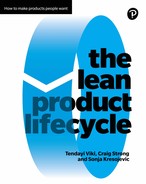Retire
7.1 Welcome to Retire
Unfortunately, all good things must come to end. When a product comes to the end of its life, there is often an emotional sense of failure or loss, sometimes with and added fear of change. As such, there is often a reluctance to retire products unless problems are severe, obvious or inherited; a costly mistake for innovation. If you wait until you have to, retiring a product might be costly in terms of both finances and brand equity.
Actively looking for products that are on a downward trajectory, have limited potential or are no longer needed to deliver your current strategy, is a healthy endeavour for a company’s long-term growth. Growth and innovation requires continuous investment of resources and energy. Whatever size your organisation, you will have a finite capacity to manage products at every stage of the lifecycle. A mindset of minimising waste and maximising value through applied effort will undoubtedly improve your product portfolio.
The opportunity cost incurred by dragging out products that should be retired is wasteful, high risk and to some degree negligent. It’s incumbent upon decision makers to ensure their efforts are applied to the most rewarding endeavours to deliver on strategic goals. This is not just for the benefit of capital return for investors, but for the security of the company’s future and those that depend on it.
Recycling retirement capital to the top of the innovation funnel or doubling down on other promising endeavours should be strategically encouraged to improve the chances of long term corporate survival. Another benefit of actively considering retirement candidates is that the activity can reveal new ways to utilise and apply existing capabilities and technologies. There are ten key points to consider when retiring products. We outline these below.
7.2 Ten key points to consider when retiring products
As you make your decisions to retire, you will be considering financial performance, customer feedback and other trend data. However, these data alone are not enough to make a conclusive decision to retire a product. Beyond finances and customer feedback, we need to make other considerations in order to make informed decisions, manage customer expectation and support employees that are affected by decisions to retire. We also have to consider the risk and impact of our decision. We have identified ten key points that can help you make your decision and manage the process of retiring a product.
 Tip
Tip
Consider positioning the employees of the retired product into an internal marketplace for talent acquisition. You can help employees utilise their existing networks, update their recognised, CVs and even hold job fairs. If you’re an enterprise with many products, you may have products moving into different lifecycle stages who are recruiting. This can help employees move to new and interesting opportunities.
7.3 Refreshing your product with adjacent innovation
As already noted, retiring a product is not just about releasing capital or reducing waste, but can be a proactive process to discover more valuable applications for the declining products or their components. By seeking more value, you may uncover new and innovative business models which would not otherwise be discovered. Remember that it is highly likely that the business environment has considerably changed since the product’s inception and the business model could be revisited.
A powerful example of the reapplication of a technology is well described by Naji Radjou and Jaideep Prabhu in Frugal Innovation – How to do better with less.64
The Retire stage in the Lean PLC can encourage a team to revisit the breadth of new opportunities that might now be attractive to them but were priced out at the time of original product conception. Technologies which have aged in wealthier western societies, could have a second life in less affluent countries where cost was originally a significant barrier. New technologies when first conceived and supported by early adopters are usually expensive to scale and thus constrained for wider market application. With a reduction in cost, the potential adjacent markets could be significantly broader. In some cases, these technologies can end up creating new categories in new markets.
To put this in context consider 3D printing. The entry level for 3D printing is still a barrier for market adoption for most. Over time as the price drops, new markets and dependent economies may emerge. The intellectual property (IP) within the older devices is in some cases recycled into newer products with cheaper and more reliable materials, making products more accessible to a broader audience. As this happens, the technology can become transformational through adjacent innovation opportunities and broader market adoption.
A case in point is the work of OpenBionics.com who use 3D printing to support amputees. Traditional prosthetics hands can cost up to £90k and take months to fit, making them too expensive for most. Using the latest 3D printing and body scanning technologies, Open Bionics can create bionic hands for just £2k and can take just five days to fit. As such, if you were in the production of original prosthetic limbs, could you revisit your business model to utilise 3D printing as above? By doing so you could lower price and increase your total addressable market.
This approach may seem like cannibalisation of your business model. However, if the product is already in decline, this may be a great option for your company. It’s important to actively measure how each product is performing against your strategic goals. Whatever size company you belong to, you will have a finite capacity of idea generation and execution. Releasing the untapped potential from existing products or teams by actively seeking to retire products, can help propel you forward and innovate.
SUBMISSION TEMPLATE
Retire review SUBMISSION
Product ownership
| Investment board | |
| Business sponsor | |
| Product owner |
Product overview
| Product name | |
| Idea description | |
| Strategic fit |
Why Retire?
What is your rationale for retiring the product?.
What impact is this having on our customers and key stakeholders?
What are your plans to mitigate impact?
What are key tasks and milestones involved in retiring the product?
Financial impact
What will be the financial impact of Retiring the product on our company?
| Expected revenue over 3 years | Expected costs over 3 years | Profit margins over 3 years (%) |
Resources and funding requested
To complete the Validate stage, we are asking for (e.g. dollars, time, people):
A case study – Nintendo
Following a series of successes in the early 1980s with arcade games, Nintendo made plans to create a cartridge-based console. Nintendo president Hiroshi Yamauchi firmly stood behind his vision of providing a family computer (famicom). His vision focused on the simplicity of the cartridge and controller, allowing the product to be more accessible to a wider range of family members. This was a key factor and resulted in having no needed for a keyboard, which at that time many found intimidating.
This idea eventually led to the creation and release of the NES, which was launched on 15 July 1983. Despite there being many games consoles prior to this idea, including the Binatone TV Master, the Atari 2600 and Nintendo’s own Colour TV-Game series, the NES leapt forward with games which engaged families across the globe.
The console offered many innovative features at the time, especially the subtle introduction of the D-Pad (Direction Pad), giving gamers more control and user engagement. In addition to this, Nintendo created some of the most iconic games of its time ranging from Super Mario, The Legend of Zelda, Donkey Kong to name a few. This grew Nintendo’s foothold as a category leader. The games have long outlived and evolved beyond the original NES capabilities and today sit across many platforms including our smartphones. However, without any doubt the NES was a huge defining moment for Nintendo.
Now younger readers or those less familiar with gaming history might see the NES today as an antique of sorts. This is especially true in the advent of Augmented and Virtual Reality with incredibly rich and powerful consoles and smartphones. However, that doesn’t mean there is no value left within the NES ecosystem.
Thirty-three years on in 2016 Nintendo decided to resurrect the old NES and package it into a smaller modified version, preloaded with 30 games called the Classic NES. Despite the obvious advancement in technology in the last 33 years, there was significant demand for the Classic NES, way greater than Nintendo even expected. Nintendo anticipated this would just be an additive product for a seasonal offering, but demand was much higher.
In comparison the original NES sold approximately 2.3 million units and the Classic NES sold 1.5 million units following increased production in just a matter of months.65 Despite the demand, Nintendo did eventually stop production to most people’s surprise. Their reasoning was that the NES was not aligned with their strategic interests. However, the demand for the Classic NES has since given rise to the resurrection of other older games consoles including the Commodore 64 Mini,66 Nintendo SNES Classic, Ataribox and more.
This example with Nintendo demonstrates two main things. First, it is possible to successfully retire your own products, before the market kicks you out. Second, there may be trapped value in older products and platforms you offer. Just because something has been around for a long time, it doesn’t mean there is no market for it. Clearly Nintendo revisited a core product decades later, applied some innovative thought into how it applies to the modern context and re-invented the technology which could have otherwise been easily overlooked.
____________________
64 Radjou, N. and Prabhu, J. (2015). Frugal Innovation: How to do more with less. London: The Economist.
65 Time (2017). Nintendo says it sold over 2 million NES classics. Available at http://time.com/4759594/nes-classic-millions-sales/.
66 Swapna Krishna, E.S. (2017). A mini version of the Commodore 64 is coming in 2018. Available at https://www.engadget.com/2017/09/29/commodore-64-mini-releases-in-2018/

